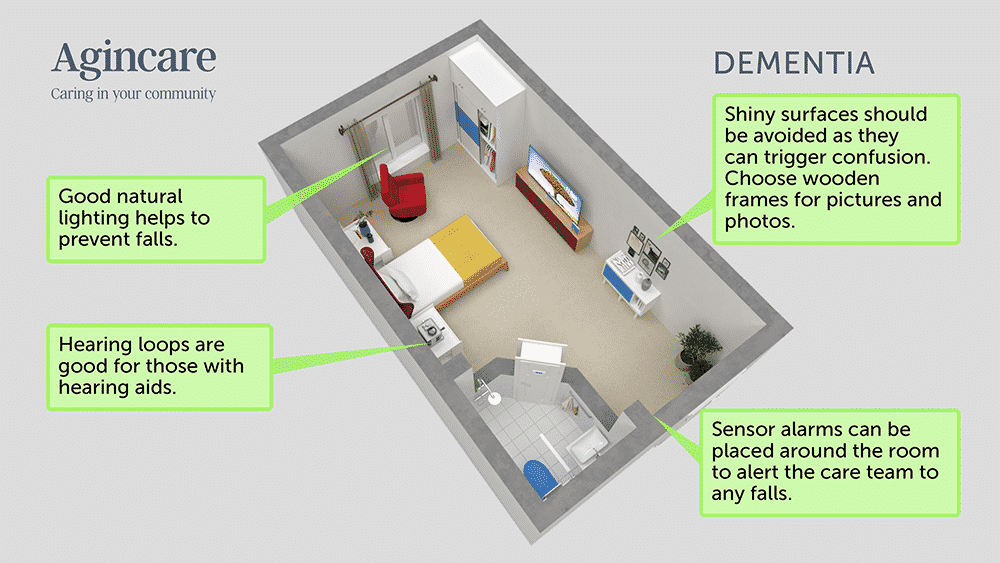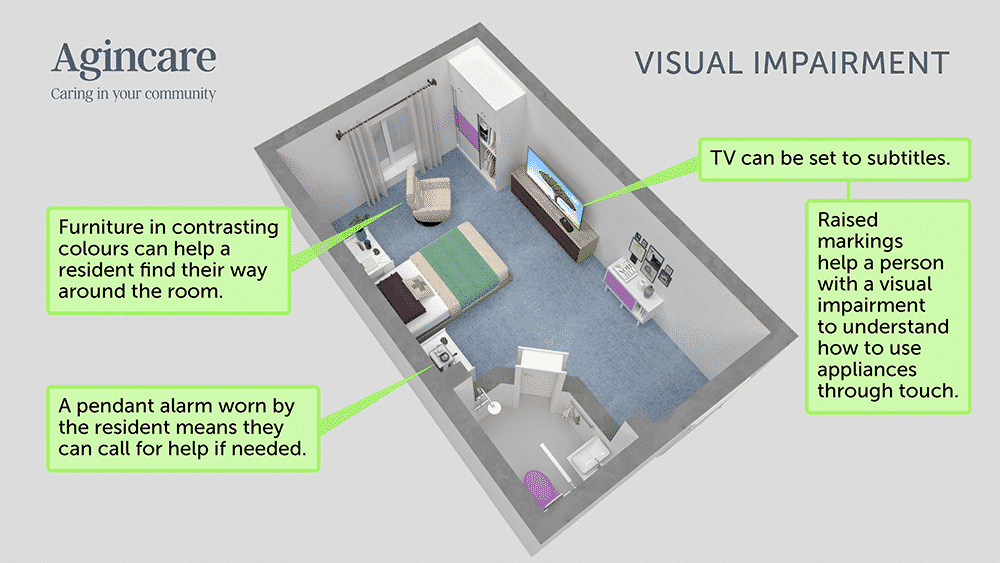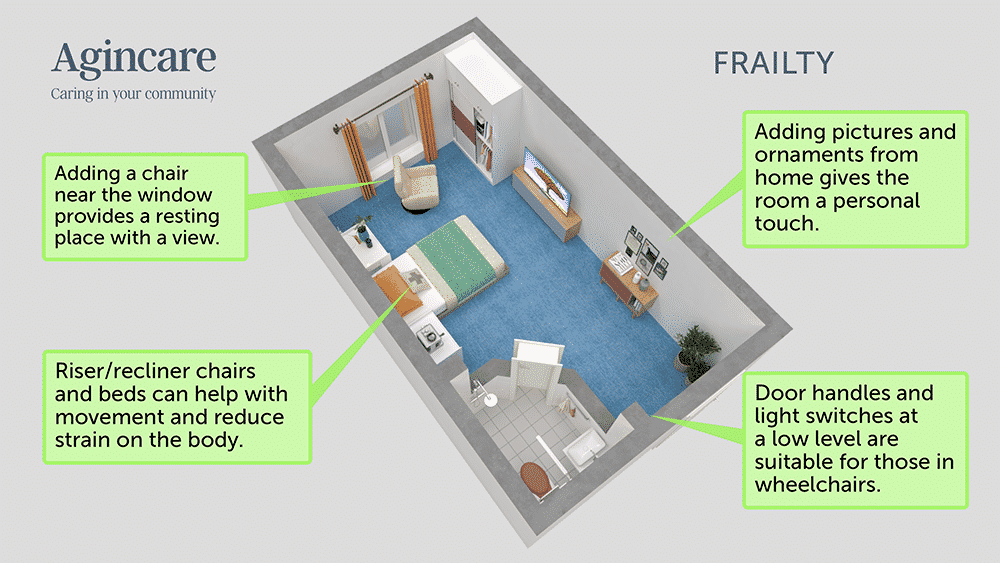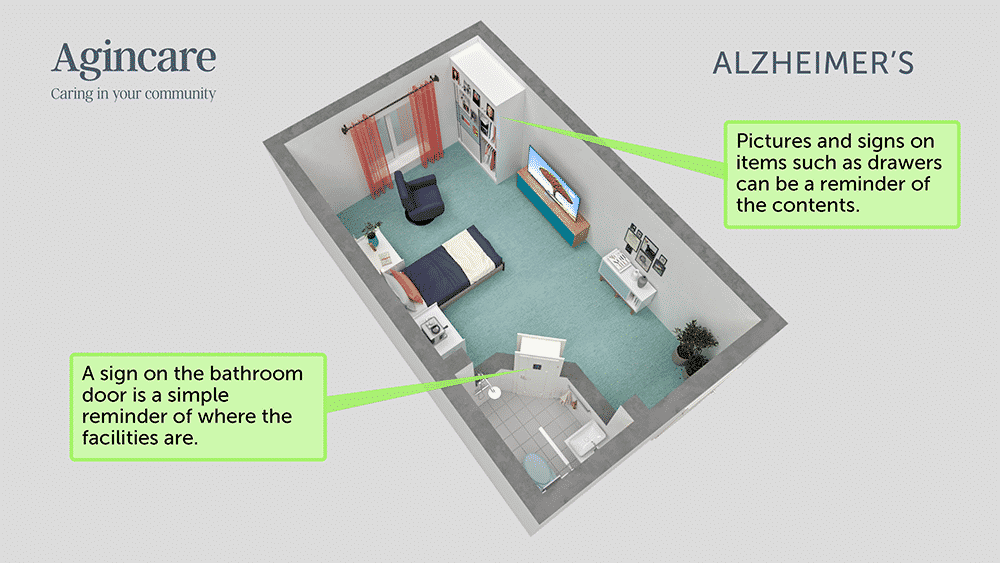If you decide that a residential care home is the right place for you to receive extra support, it is vitally important that you choose somewhere that can properly meet your needs.
We understand the importance of bespoke care home rooms that best suit the needs of our residents. To bring our ideas to life, we‘ve created a series of 3D floorplans showing the ideal room set-ups for older people living with dementia, frailty, Alzheimer’s, a visual impairment or a hearing impairment.
Adding personal touches to a care home room to help people living with dementia

When it comes to the ideal care home room for someone with dementia, familiarity and stability are key. Personal touches are encouraged – framed family photographs and other personal memorabilia are comforting constants on the walls, bedside tables and dressers.
However, it’s important to note that shiny surfaces and mirrored items can trigger confusion and distress, so wooden or matte frames are best. And also, changing the appearance of the room should be avoided where possible. Stability and familiarity are key in avoiding confusion, so temporary decorations at Christmas and birthdays are best avoided.
Aside from adding personal touches, someone living with dementia would benefit from a room that has plenty of natural light. Thin, lightweight curtains are helpful in achieving this.
Finally, technology can be used to maximise the resident’s safety. Sensor alarms should be placed around the room to alert the care team to any falls, as well as automatic motion sensor lighting to light a resident’s way. Hearing loops can also be provided for those with hearing aids, while personal smart speakers can be used by residents in their rooms.
The ideal care home room for those with a visual impairment

Unsurprisingly, finding their way safely around their care home room is the most important thing for a resident with a visual impairment. To make the room as user-friendly as possible, key pieces of furniture and appliances, such as wardrobes, cabinets, doors and the toilet, as well as light switches, sockets and handles, should be a contrasting colour to the walls and the floor. Additionally, thin curtains allowing plenty of natural light into the room are a good idea.
Raised markings on the TV remote control, lamps and plug sockets can make them easier to find. Similar raised markings can also be used to help guide the resident to flush the toilet, turn on the tap in the bathroom and control the shower.
Finally, each resident with a visual impairment should be issued with a pendant alarm system. The resident should wear it all the time as it’s used to call for help in the event of a fall.
Improvements to care home rooms for those with a hearing impairment

Whether a hearing impairment is age-related – coupled with other conditions – or congenital, a care home room designed with this condition in mind must look to tackle two main areas.
Firstly, using both a person-centred approach and technology to aid in communication between the resident and the care team, as well as making day-to-day activities as easy as possible. And, secondly, minimising unnecessary background noise inside the room to make focused hearing possible.
As vocal communication may not be the best form of communication for residents with hearing impairments, details of activities, events or routine updates should be written or available in sign language. This can either be done with a notice board in each room or by care staff trained in sign language. The best option may simply depend on an individual’s preferred method of communicating.
In order to aid a resident’s hearing, the use of simple technology such as a conversation listener or a hearing loop that can pair with hearing aids can be provided. This can help not only to improve communications, but also allow for the resident to more comfortably watch television or listen to music. Finally, to reduce background noise, thick curtains and carpets should be fitted. This will improve the room’s acoustics and allow for more focused hearing.
Care home rooms with frailty in mind

Frailty is often the reason why older people decide to move into a care home. A care home can use modified appliances, technology and personal touches to help frail residents feel as safe and comfortable as possible.
Grab rails should be installed in strategic places around the room, such as near the bed, chairs and bathroom. These give the resident support when they are moving around. Additionally, all grab rails, door handles, windowsills and light switches should be placed at a lower-than-usual height to allow for easy use, including for those in wheelchairs.
The floor should not be shiny or slippery, and furniture should not obstruct doorways or pathways to allow for easy movement and remove any trip hazards.
Getting up out of a chair or bed can be difficult for frail people. Installing technology, such as rising and reclining chairs and beds, will help reduce excess strain on the body. Ideally, armchairs will be positioned near a window to give the resident a resting place with a view.Finally, personal touches, such as framed photographs and other ornaments, on dressers and windowsills will be comforting homely constants.
The ideal care home room for those with Alzheimer’s

As with care home rooms designed for those with other forms of dementia, rooms for residents with Alzheimer’s should focus on being as familiar and stable as possible.
As well as having personal items, such as framed photographs and other memorabilia, signs and labels can be used as little reminders of where to find the bathroom and which drawers and cupboards store which items of clothing. Picture signs can be used as an easy reminder of the contents of drawers and cupboards too.
As well as being surrounded by familiar things, someone living with Alzheimer’s would also benefit from a light and airy room. Ensuring the room has plenty of natural light during the day can help to prevent falls.
Sensor alarms around the room can alert a member of the care team in the event of a fall, and automatic motion sensor lighting can be used to minimise the need for switches. Additionally, hearing loops can be provided for those with hearing aids to help with communication.
If the time comes for you or a loved one to seek extra care and support from a residential care home, remember that it is important to select a home that can cater for any specific needs and requirements.
From special technology and specific décor to simply providing a sense of familiarity and normality through the use of personal items, we all deserve a room that’s comfortable and safe.
